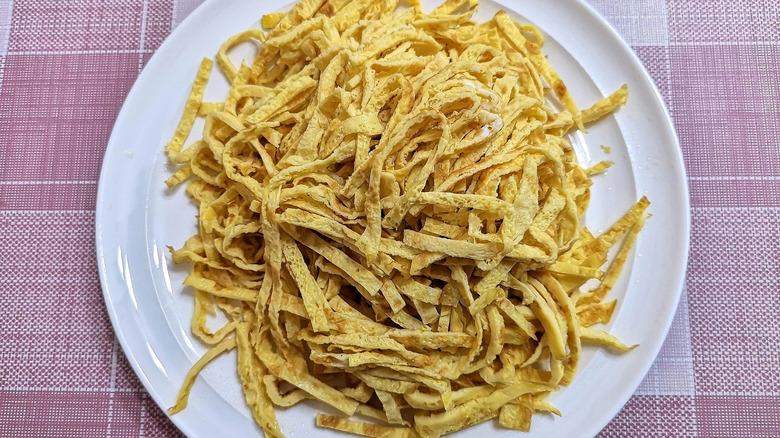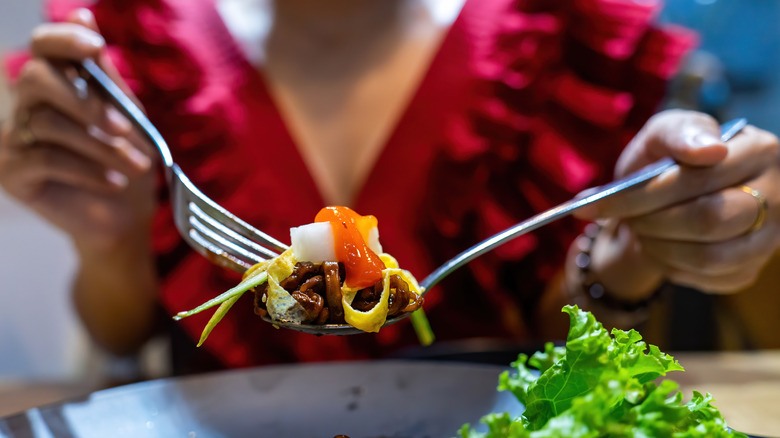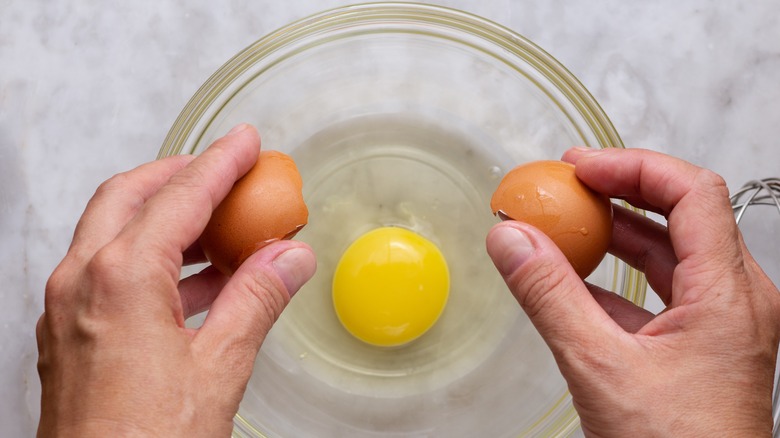Roll And Slice Your Next Omelet For Protein-Packed Pretend Noodles
Although your nonna might make quick work of rolling out pappardelle, some people might prefer a more protein-forward option in the pasta bowl. If vegetables can be transformed into zoodles, there's no reason you can't crack an egg and cut it into tasty ribbons of omelet faux noodles.
The idea of using a thin egg omelet or crepe cut into ribbons as noodles stems from the Japanese dish kinshi tamago. Translated to mean golden threads of eggs, it is used as a garnish to add color and texture to a dish. The lively yellow against warm brown tones can bring excitement to the first bite. Additionally, the velvety egg can balance a crispy vegetable or add a softness to contrast with a hearty piece of protein. It is another way to approach a well-composed texturally complex dish.
The eggs, cooked into a delicately thin layer, rolled, and cut into strips, can add a hint of savory, sweet flavor to a complex dish. Whether it is a touch of mirin, a sprinkle of togarashi, or just a little finishing salt added to the egg, those thinly cut pieces can become the flavor pop on the plate.
Length and width matters with egg crepe noodles
While a delicate egg crepe requires a deft hand, transforming that thin layer into ribbons of delicious faux noodles is just as challenging. Although the old saying "measure twice cut once" might be a handyman's mantra, the concept applies to egg crepe noodles. There is no do-over once the knife makes the first cut.
The key to making the faux noodles is the size. If the idea is to mimic noodles in both appearance and texture, the width and length is important. Whether short and wide or long and thin, it is best to think about how these pretend noodles will be served.
For example, long, skinny noodles could work in a pad thai or with a thinner sauce. Mixed with smaller vegetable pieces or bite-sized pieces of chicken, the contrasting sizes add to the eating enjoyment. In contrast, a wide, thick noodle would be preferred for a hearty sauce. Although the faux egg noodles might not be substantial enough for a layered pasta dish, they can stand up to a Sunday gravy.
The secret to a perfectly thin egg for faux noodles
Mastering a perfectly thin egg crepe for faux noodles requires practice. When trying this cooking concept, the key idea to remember is to just let the eggs cook. Unlike a scrambled egg where a little pan shake or spatula nudge adds to the fluffy texture, these eggs need to sit undisturbed. After just barely coating the bottom of a non-stick pan with the egg mixture, it should cook for a few minutes. Once set, gently move the entire circle to a cutting board. Once cooled slightly, roll it and slice it to the desired thickness and width.
If the egg crepe tears, breaks, or otherwise becomes less round, do not fret. Just like with certain types of pasta that are roughly cut or torn, imperfection is not the end of the world. No one has a Michelin judge scrutinizing that weeknight dinner. The taste, texture, and flavor balance matter more than perfectly even egg ribbons. Cracking the secret to a great faux egg noodle might take a little practice, but the resulting dish is worth the effort.


